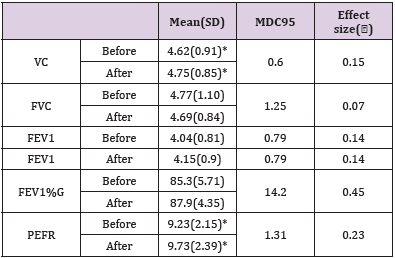Impact Factor : 0.548
- NLM ID: 101723284
- OCoLC: 999826537
- LCCN: 2017202541
Yusuke CHIGIRA1*, Misaki BABA2 and Ikuri MIYAZAKI2
Received: September 09, 2022; Published: September 21, 2022
*Corresponding author: Yusuke CHIGIRA, Department of Physical Therapy, Faculty of Health Science, Takasaki University of Health and Welfare: 501 Nakaoorui, Takasakisi, Gunma 370-0033, Japan
DOI: 10.26717/BJSTR.2022.46.007325
While examining elderly patients with pneumonia, we focused on a reduced coughing ability as the most important factor associated with its development. This study examined the effects of an expiratory muscle strength training (EMST) method to improve the coughing ability of young individuals in consideration of its clinical use for the elderly.
Fourteen healthy males and females aged 20 to 30 without respiratory disease performed EMST by exhaling while pursuing their lips and increasing the abdominal pressure after a maximum inspiration by contracting their abdominal muscles. During this procedure, an expiratory muscle training device (Calorie Breath; Needs Co., Ltd.) was used to create expiratory resistance (Figure 1). A 10-minute EMST session was performed at the maximum loading level once daily for 3 weeks, and intervention-related changes in the values were examined. The following items, representing the respiratory function, were measured: the vital capacity (VC), %vital capacity (%VC), forced expiratory volume in one second (FEV1.0), %forced expiratory volume in one second (%FEV1.0), forced expiratory volume 1.0% (FEV1.0%), and peak flow (PEF).
Although the intervention period was short, at 3 weeks, the respiratory function generally improved.
Improvements in the FEV1.0 and PEF values, associated with expiratory and coughing abilities, were particularly marked (Table 1).
Table 1: Effects of an Expiratory Muscle Strength Training.

Note: *p<0.05
VC: vital capacity.
FVC: Forced Vital Capacity
FEV1.0%: forced expiratory volume in 1 second percent
PEFR: Peak flow
The tendency of the respiratory function to generally improve, as well as the improved expiratory ability, may have been a result of increases in the abdominal rectus, transverse abdominal, and exand internal oblique muscle strength needed to enhance the intraabdominal pressure when coughing or during forced expiration. In a study involving healthy individuals and Chronic Obstructive Pulmonary Disease (COPD) patients, expiratory muscle training improved their respiratory function related to the expiratory flow rate [1]. Kim, et al. [2] provided expiratory muscle training for a healthy elderly group and reported that their maximal expiratory muscle strength increased. It may be possible to reduce the risk of aspiration pneumonia due to the difficulty in removing foreign bodies and secretions in the respiratory tract using this method for the elderly to strengthen their expiratory muscles, and consequently improve their coughing ability.
The authors declare no conflict of interest.
This study was supported by many people. The authors would like to express their sincere gratitude to staff and users of the study facility.


